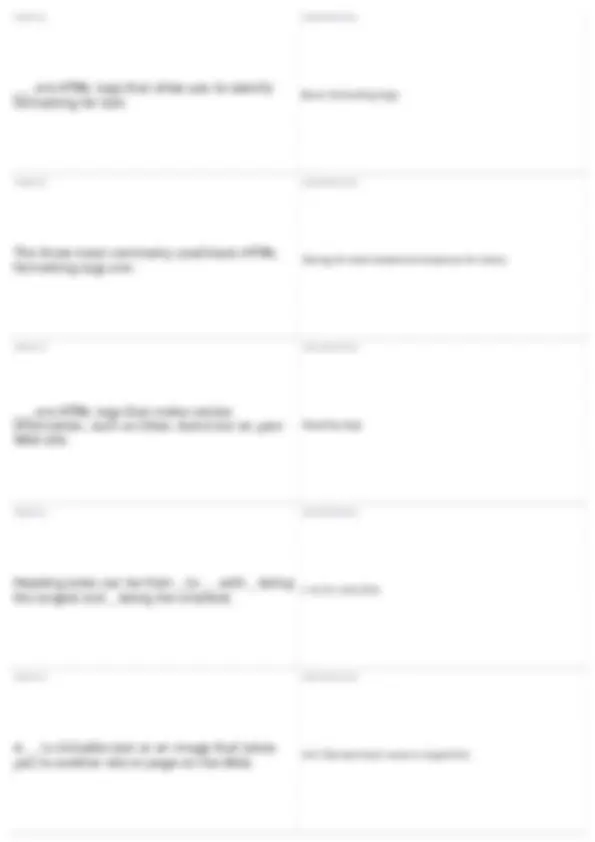














Study with the several resources on Docsity

Earn points by helping other students or get them with a premium plan


Prepare for your exams
Study with the several resources on Docsity

Earn points to download
Earn points by helping other students or get them with a premium plan
Community
Ask the community for help and clear up your study doubts
Discover the best universities in your country according to Docsity users
Free resources
Download our free guides on studying techniques, anxiety management strategies, and thesis advice from Docsity tutors
Chapter 4,6,7. Extended Learning Molecule: E, F, D. Class: IT - Database Management 1 - Introduction; Subject: Information Technology; University: University of Louisiana at Lafayette; Term: Forever 1989;
Typology: Quizzes
1 / 20

This page cannot be seen from the preview
Don't miss anything!













-find or recognize a problem, need, or opportunity. Problems come in many forms: Consistent customer requests for new product features Threat of new competition Declining sales rising costs etc. etc. TERM 2
DEFINITION 2 -consider possible ways of solving the problem (find fixes) TERM 3
DEFINITION 3 -weigh the merits of each solution (pick a fix) TERM 4
DEFINITION 4 -to carry out the solution (apply the fix) TERM 5
DEFINITION 5 -processing a certain information in a specified way so that you will always get the right answer. -No 'feel' or intuition is necessary.
-one for which there may be several 'right' answers, without a sure way to get the right answer TERM 7
DEFINITION 7 -a highly flexible and interactive system that is designed to support decision making when the problem is not structured - Decision support systems help you analyze, but you must know how to solve the problem, and how to use the results of the analysis TERM 8
DEFINITION 8 -consists of both the DSS models and the model management system -is a representation of some event, fact, or situation. - stores and maintains the DSS's models. TERM 9
DEFINITION 9
DEFINITION 10 -allows you to communicate with the DSS
Determining budgets Gathering business requirements Designing models TERM 17
DEFINITION 17 Planning Analysis Design Development Testing Implementation Maintenance TERM 18
DEFINITION 18
DEFINITION 19 Define the system to be developed Set the project scope Develop the project plan including tasks, resources, and timeframes TERM 20
DEFINITION 20
DEFINITION 22
DEFINITION 23
DEFINITION 24
DEFINITION 25
Technical architecture Modeling TERM 32
DEFINITION 32
DEFINITION 33
DEFINITION 34
DEFINITION 35
DEFINITION 37
DEFINITION 38
DEFINITION 39
DEFINITION 40 Identify basic requirements Develop initial prototype User review Revise and enhance the prototype
DEFINITION 47 Write detailed user documentation: User documentation - highlights how to use the system Provide training for the system users: Online training - runs over the Internet or off a CD-ROM Workshop training - is held in a classroom environment and lead by an instructor TERM 48
DEFINITION 48 use both the old and new system simultaneously TERM 49
DEFINITION 49 discard the old system completely and use the new TERM 50
DEFINITION 50 start with small groups of people on the new system and gradually add more users
implement the new system in phases TERM 52
DEFINITION 52
DEFINITION 53 Build a help desk to support the system users Provide an environment to support system changes TERM 54
DEFINITION 54 Waterfall methodology Rapid application development (RAD) Extreme programming (XP) Agile methodology TERM 55
DEFINITION 55 Insourcing Outsourcing
Reduces degree of control Increases vulnerability of your strategic information Increases dependency on other organizations TERM 62
DEFINITION 62 two or more computers connected so that they can communicate with each other and share information, software, peripheral devices, and/or processing power TERM 63
DEFINITION 63 -Each computer must have a network interface to provide a doorway for information -The network usually has at least one connecting device -The network must have communications media to transport information -Each computer must have software to move information in and out of the computer -These four principles apply to all networks, large and small TERM 64
DEFINITION 64 -An Ethernet network card in each computer or a wireless card in each laptop -Network cables to transmit signals, or no cables for wireless -A DSL or cable modem connection and a broadband/home router TERM 65
DEFINITION 65 an expansion card or PC card that connects your computer to a network
the most common type of network interface card -Built into the motherboards of many new computers looks like a telephone jack, but wider TERM 67
DEFINITION 67 device that allows a computer to use radio waves to access a network -Connects to hub or switch with a cable like a wired computer -May be built into broadband router and not require separate cabling TERM 68
DEFINITION 68 a device to connect computers together to share DSL or cable Internet service in a home or small office TERM 69
DEFINITION 69 a device that connects computers into a network and repeats all transmissions to every connected computer -Only one computer can transmit at a time -All computers see every message -Can have collisions when two computers try to transmit at the same time TERM 70
DEFINITION 70
Phone line and dialup modem Phone line and DSL modem Cable TV line and cable modem Satellite modem Dedicated high-speed business lines TERM 77
DEFINITION 77 -high-capacity telecommunications line capable of providing high-speed Internet service -All Internet access methods on the previous slide are broadband except the dialup modem TERM 78
DEFINITION 78 allows you to send voice communications over the Internet and avoid long-distance toll charges - No long-distance calling cost Ex. Skype TERM 79
DEFINITION 79 Confidentiality Authenticity Integrity Availability TERM 80
DEFINITION 80 information can be obtained only by those authorized to access it -Bank statements, credit reports, employee evaluations -Threatened by capture of network transmissions and easily-guessed passwords
information really comes from the source it claims to come from Ex. Military orders, medical diagnoses, stockbroker directions -Threatened by fraudulent e-mails and misspellings of popular Web site names TERM 82
DEFINITION 82 information has not been altered Ex. Bank balance, corporate Web site, prescriptions, credit card charges -Threatened by forged network transmissions and faulty server software TERM 83
DEFINITION 83 a service or resource is available when it's supposed to be Ex. Mail-order Web site, corporate e-mail server - Threatened by network failures, faulty server software, and high volumes of malicious network traffic TERM 84
DEFINITION 84 protects a computer from intruders TERM 85
DEFINITION 85 watches for and reports intrusion attempts
Basic formatting tags TERM 92
DEFINITION 92 Strong for bold Underline Emphasis for italics TERM 93
DEFINITION 93 Heading tags TERM 94
DEFINITION 94 1 to 6 1 and 6 Ex. TERM 95
DEFINITION 95 link (the technical name is hyperlink)
Links to other Web sites or pages Links to downloadable les Links to e-mail TERM 97
DEFINITION 97 a href=address or le name>text to appear on screen TERM 98
DEFINITION 98 img sr=lename.extensionheight=pixel count width=pixel count>